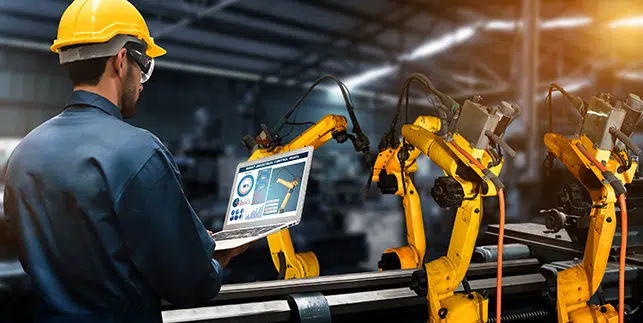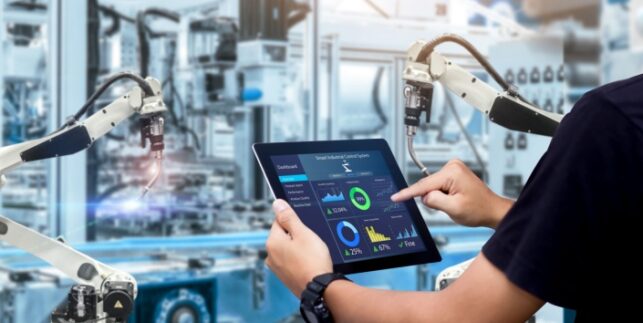Smarter Preventive Maintenance: Improve Uptime and Efficiency with Real-Time Operational Intelligence

The technology boom of Industry 4.0 has caused a dramatic increase in the amount of data available from the shop floor. Among this data are the clues to discovering when a machine needs maintenance—especially in an emergency—and what type of maintenance it needs. When that data is collected into a real-time operational intelligence (RtOI) system, these clues can trigger alerts that are sent to the right people at the right time to help make preventive maintenance smarter.
Read on to learn what smarter preventive maintenance looks like and how it can benefit manufacturing.
Preventive Maintenance: Then and Now
In the past, preventive maintenance consisted of manual checks on a regular schedule, often daily, to prevent the need for corrective maintenance. While this method allows shop floor supervisors to plan their production schedule around their maintenance schedule, it does not take into consideration the machine’s actual condition. It is also an inefficient use of staff time and shop floor resources that causes unnecessary delays and downtime.
This old approach to preventive maintenance, says Gary Mintchell, Founder of The Manufacturing Connection, offered a false sense of security: “You sent a technician out on rounds. They tweak this, adjust that, check something else. Then tomorrow the machine or process would develop a problem.”
The moment-in-time nature of manual preventive maintenance means machines are still at risk of failure between inspections. Smarter preventive maintenance addresses this vulnerability through continuous, automated monitoring. “Learning what is happening is the first step,” says Mike Nager, Manager at Festo Didactic. “Without a constant understanding of the state of each machine, a machine is at risk of partial or total failure at any point between maintenance checks.”
This continuous condition monitoring is done by sensors employing techniques like ultrasonic analysis, thermal imaging, and vibration analysis, among others. These sensors receive data from machines on the shop floor and collect it into a central RtOI system. This central data repository can be accessed by anyone who needs it whenever they need it, providing an end-to-end view of the status of the shop floor at any given time.
Turn Data Into Action
Having real-time data can only improve your maintenance efficiency if it’s acted upon, of course. Mintchell suggests that manufacturing companies need to take advantage of “software with much better data input, more precise analytics, and mobile devices that permit instant feedback.” This type of software solution makes it easier to make productive use of data.
When setting up these tools, factory leaders should start by analyzing previous failure states to pinpoint the early symptoms that can lead to machine failure. Once identified, these failure modes can be entered into the RtOI system. When a failure mode is detected, an automated alert is sent immediately to the relevant staff so they can then take action to address the problem.
When used for preventive maintenance,these tools take advantage of continuous monitoring and immediate access to data through an RtOI system which can remove guesswork from the process.
The Benefits of Smarter Preventive Maintenance
A smarter preventive maintenance system has multiple benefits, both obvious and subtle:
Improved uptime. Helen Yu, Founder & CEO, Tigon Advisory Group, says the first benefit of targeted, as-needed maintenance is how “it improves the operations’ uptime and productivity.” Uptime and productivity are linked: the more uptime you have, the more you can produce, and ultimately the more revenue you can generate.
Machine-on repairs. Fewer unnecessary maintenance checks are not the only way uptime and productivity are increased. In a targeted, as-needed maintenance system, most issues can be detected by the sensors and sent to staff early enough that they can be addressed without needing to shut down the machine completely. This dramatically reduces or even eliminates stop and restart time so your operation can get back to normal faster.
Fewer repairs and replacements. When machines are maintained “Financially, you will achieve cost savings on both maintenance and replacement,” says Yu. “Since the maintenance is smartly applied based on the asset’s condition versus fixed, predetermined schedules, it extends the life expectancy of your fixed assets.” This results in a savings of money from not having to invest in replacement parts or whole new machines. It also means you can avoid stoppages due to replacing a machine, meaning your operation can stay up and running longer.
Saved staff time. When machines receive preventative maintenance based on specific, automated diagnostic alerts, they can be maintained without the need for a time consuming manual check. This makes technicians “much faster and more effective,” Mintchell says, because they only work on a machine on an as-needed basis.
Moreover, when factory staff are not busy checking machines that aren’t broken, they are able to be productive elsewhere on the shop floor. This can translate into lower overhead by allowing factory leaders to reduce staff or retain staff and increase production capacity. Either way, staff time saved is a significant benefit to your company’s budget and your staff’s happiness.
See the Benefits for Yourself
The data to track which machines need tending to is available—it just needs to be identified and made actionable. When your machines are outfitted with advanced condition state sensors, and the data they generate is collected into an RtOI system, your technicians can focus only on machines that actually need maintenance, rather than relying on routine checks.
To learn more about how Matics’ RtOI solution makes preventive maintenance smarter, request a demo.





